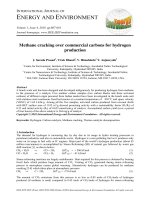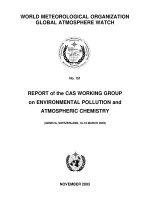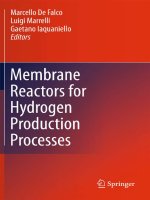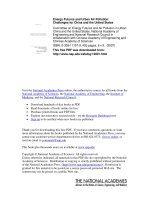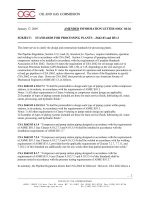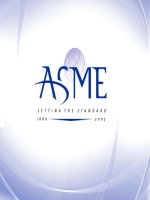Code for Hydrogen Pipelines Hydrogen Pipeline Working Group Workshop pps
Bạn đang xem bản rút gọn của tài liệu. Xem và tải ngay bản đầy đủ của tài liệu tại đây (105.33 KB, 18 trang )
2
Code for Hydrogen
Pipelines
Hydrogen Pipeline
Working Group Workshop
Augusta, Georgia
August 31, 2005
Louis Hayden, PE
Chair ASME B31.12
3
Presentation Outline
• Approval for new code development
• Charge from BPTCS to B31
Standards Committee for Hydrogen
Piping/Pipeline code development
• B31.12 Status & Structure
• Hydrogen Pipeline issues
• Research Needs
• Where Do We Go From Here?
4
Code for Hydrogen Piping
and Pipelines
• B31 Hydrogen Section Committee to develop
a new code for H
2
piping and pipelines
– Include requirements specific to H
2
service for power,
process, transportation, distribution, commercial, and
residential applications
– Balance reference and incorporation of applicable sections
of B31.1, B31.3 and B31.8
– Have separate parts for industrial, commercial/residential
and pipelines
– Include new requirements for construction, operation, and
maintenance
5
Performance-Based vs.
Prescriptive Standards
• Performance-Based
– States goals and objectives to be achieved
– Describes acceptable methods to determine goals and
objectives have been met
– Focuses on desired characteristics of final product
• Prescriptive
– Prescribes materials, design, construction requirements
without stating goals and objectives
– Focuses on requirements for processes to produce the
final product
• ASME standards include both prescriptive
and performance-based elements
6
Hydrogen Standards
Development Project Schedule
• Task force Recommendations- Complete
• BPTCS Action- Complete
• Technical Reports: Jul ’04 – Nov ’05
• Draft Standard Available: Nov ’05
• B31 Standards Committee: Nov ’05 – Nov’06
• Finalize Standard : Mar ’07
• Publish : 3
rd
Quarter ‘07
7
ASME B31.12 Structure and Basis
• B31.12 is divided into three subsections
– Section A: Industrial Piping
– Section B: Pipelines and Distribution Piping
– Section C: Residential piping
• There is also a section for the common use
and reference by sections A, B and C
8
Section B: Pipeline and
Distribution Piping
• Model document for section B is
ASME B31.8
• Anticipated operating ranges:
– Pressure: full vacuum to 3,000 psig
– Temperature: - 40˚F to 300˚F
9
Common Section
• This section of the code will be located at
the front of the code book and contain the
following information:
– Scope of the code
– Materials section
– Welding and forming section
– Operation and maintenance section
• The above sections will be referenced by
Sections A, B and C.
10
Hydrogen Pipeline Issues
• Materials
- Loss of 30% in toughness &
15% burst strength
- Rapid hydrogen assisted
fatigue crack growth
- Sustained-load cracking in
HAZ of welds
11
Hydrogen Pipeline Issues
• Materials (cont’d)
- Are micro-alloyed steels more
resistant to the effects of
hydrogen environments
- Do FRP pipes offer advantages
over metallic pipe in hydrogen
service
12
Hydrogen Pipeline Issues
• Materials (cont’d)
- Liner material for FRP pipe
- Design analysis method for
FRP pipeline system
- Expected design life of FRP
Pipeline
13
Hydrogen Pipeline Issues
• Public Perspective & Education
- Common perception of
hydrogen
- Public Education with real
information
14
Research Needs
• Testing of all commonly used pipeline
materials for loss of fatigue and impact
strength in a high pressure hydrogen
environment. Research the effects of
pressure cycling on mechanical properties
• Testing of pipe welds for sustained-load
cracking for all commonly used pipeline
materials. Review as welded, post weld heat
treated and annealed weld performance
15
Research Needs
• Determine if FRP pipes with metallic or
plastic liners are viable alternatives for
metallic pipes. Test joining methods for
hydrogen compatibility. Develop a
simplified analysis method for these pipes.
• Testing of commonly used plastic pipe
materials for compatibility with high purity
hydrogen environments. Test bonded and
fusion joints for hydrogen resistance
16
Where Do We Go From Here?
• Near term, the ASME B31.12 Task Group
will utilize “Design Factors” to make
system design more conservative until
actual material test data is available
• Encourage Risk Analysis of converted and
new hydrogen pipeline systems
• Impose System Integrity Management
using ASME B31.8S as a model
17
Where Do We Go From Here?
• Require in-service inspection, system
maintenance and operator training with
qualification for converted and new
systems. Reference B31Q (not yet
published)
• Review results of material testing
programs, operating results and service
histories and adjust ASME B31.12 as
needed
18
Where Do We Go From Here?
• Education of the public through a
joint effort by DOE in partnership
with ASME.
